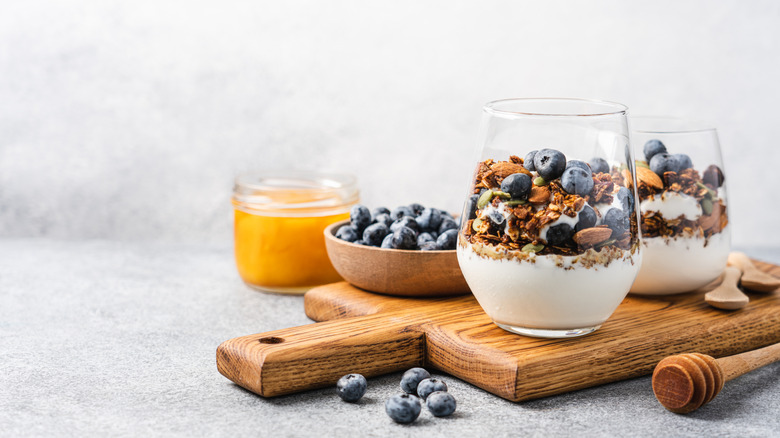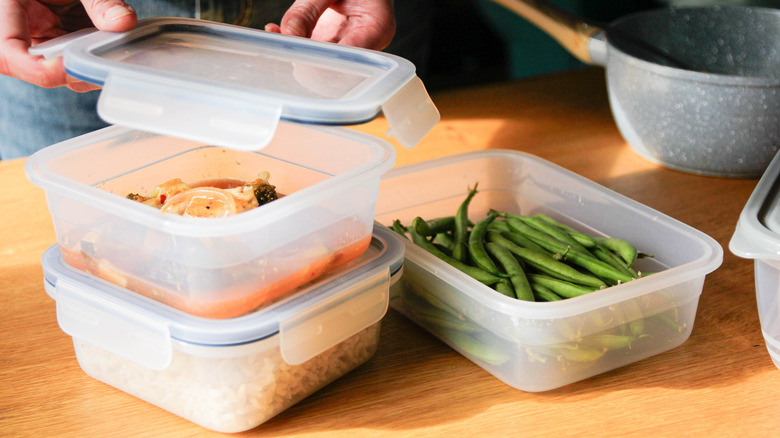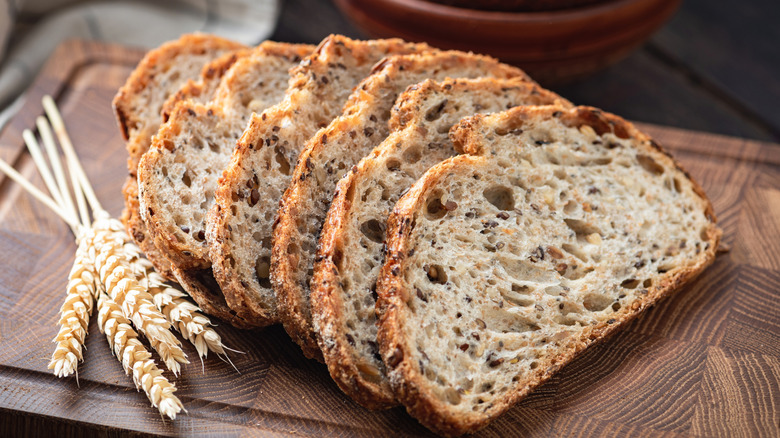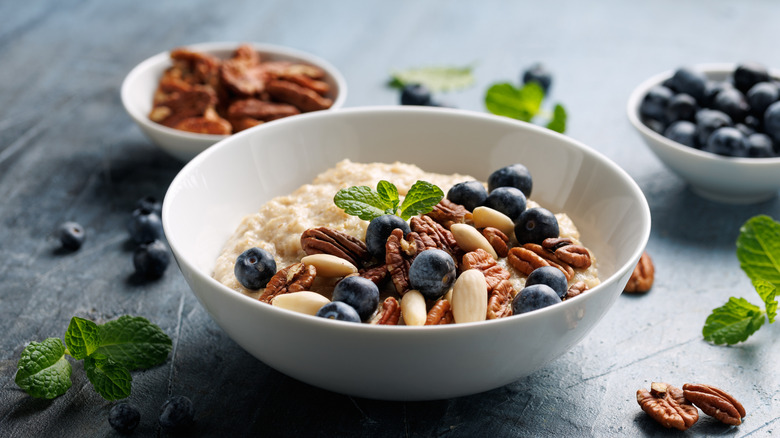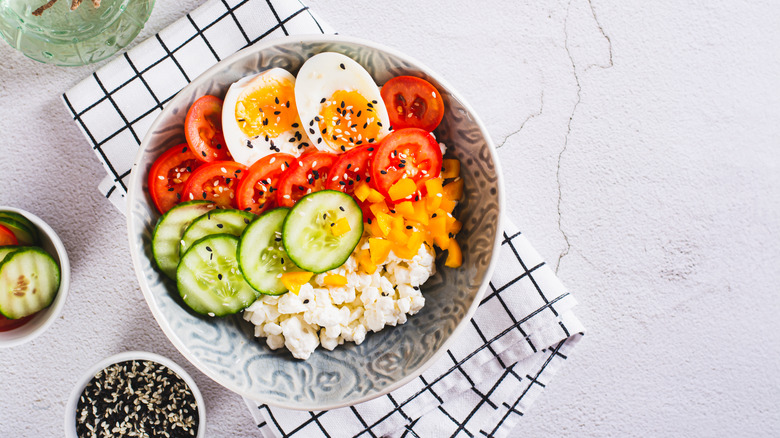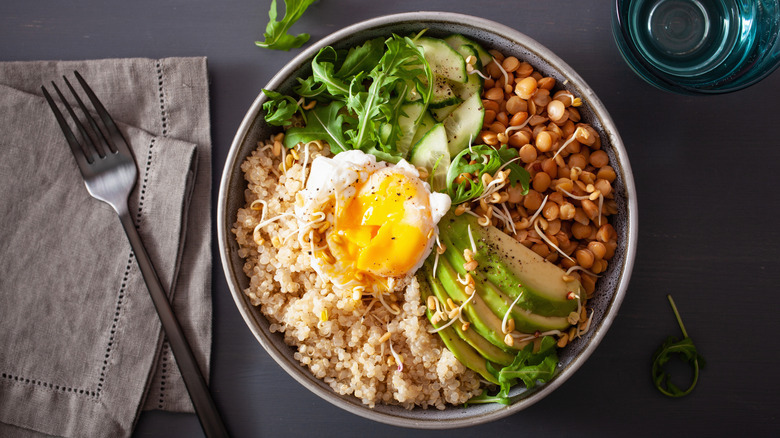The 10 Best Food Hacks To Eat 30 Grams Of Protein For Breakfast
We may receive a commission on purchases made from links.
Many traditional breakfast options often include toast, cereal, or fruit, which have become popular due to their convenience and ease of preparation. However, they might lead to increased feelings of hunger by mid-morning or struggles with energy dips before lunch. The reason for this is that these breakfasts often lack the one nutrient that helps keep you full, focused, and energized: protein. Actually, according to the American Society for Nutrition (ASN), this may be the case for most Americans, as they tend to consume very little protein (roughly 10 grams) at breakfast. On the contrary, eating a high-protein breakfast (defined in several studies as one that includes up to 35 grams of protein) offers numerous science-backed benefits. In fact, dietitians recommend that the best time to eat protein is during this meal.
For example, per a review published in the Journal of Obesity and Metabolic Syndrome, protein plays a key role in body weight and body composition by regulating hunger hormones and preserving fat-free mass. This means that it reduces cravings and increases satiety, while also maintaining lean muscle mass when the body is reducing fat. Moreover, according to a study published in Nutrients, a protein-rich breakfast has also been linked to better blood glucose control throughout the day, meaning that it can help stabilize energy levels and minimize the mid-morning crashes that often follow a carb-heavy meal (via The Health Institute). So, how can you get 30 grams of protein onto your plate without spending hours in the kitchen? This article shares 10 practical, delicious, and time-saving hacks to help you reach your protein target, regardless of whether you prefer savory or sweet, plant-based or meat-inclusive, and fast or make-ahead breakfast options.
Supercharge your eggs
Eggs are a breakfast staple for good reason: they're versatile, quick to prepare, and naturally rich in high-quality protein. But if you're aiming to hit the 30-gram mark, two scrambled eggs alone (with about 6 grams of protein each) won't get you there. The good news is that you can easily supercharge your eggs with a few smart upgrades. For starters, you can boost your eggs' protein count without adding extra fat or cholesterol by combining them with egg whites, which blend seamlessly into scrambled eggs or omelets. This is because nutrients in eggs are sort of divided by section, with the whites containing the majority of their protein, while the yolks hold all the fat (via Healthline). Thus, simply adding two egg whites to two whole scrambled eggs can increase your protein count from 12 grams to a total of 18 grams.
Next, consider adding some protein-rich toppings or fillings. For example, a quarter cup of low-fat cottage cheese adds 6 grams of protein, thereby increasing the protein content of your eggs to 24 grams. Additionally, tossing in just two slices of turkey breast, which provide about 4 grams of protein each, ramps up your breakfast's protein content to a total of 32 grams. And just like that, with these simple tweaks, your everyday eggs can become a protein powerhouse. Remember that you can always add some veggies to the mix, like spinach, tomatoes, or onions, for fiber, flavor, and variety, and if you'd rather keep your eggs meat-free, just swap the turkey for extra cheese or egg whites.
Choose high-protein Greek yogurt parfaits
For those who prefer to start the day on a sweeter note, a Greek yogurt parfait is one of the easiest and most delicious ways to pack in protein. Plus, there's no cooking required. However, when it comes to crafting a 30-gram protein parfait, you have to keep in mind that not all yogurts are created equal. Unlike regular yogurt, Greek yogurt undergoes a straining process that filters out the whey, resulting in a creamier, more concentrated yogurt with a higher protein content (via the Institute of Food Technologists). For example, while a 100-gram serving of regular plain yogurt provides approximately 4 grams of protein, the same serving of Greek yogurt packs 10 grams, over twice as much.
Thus, to build your parfait at home, start with one 156-gram Greek yogurt container (or about half a cup), which delivers around 16 grams of protein, depending on the brand. Then, layer the parfait with other protein-rich toppings that also add texture, healthy fats, and satiating power, such as two tablespoons of peanut butter or almond butter, which provide 7 grams and 6 grams of protein each, two tablespoons of nuts for an additional 6 grams of the macronutrient, and one and a half tablespoons of hemp seeds, which pack 5 grams of protein, for a total protein count of 34 grams. Lastly, since parfaits are highly customizable, add some fresh fruit, like berries, sliced bananas, or diced apples, for a touch of sweetness, and sprinkle a bit of cinnamon or cacao for a final touch. You can prep this high-protein breakfast the night before in a jar for grab-and-go convenience or assemble it fresh in minutes in the morning.
Drink a protein smoothie
Smoothies hit the breakfast jackpot for many people due to their customizability and practicality as a quick, on-the-go meal. But if your go-to recipe includes just fruit and almond milk, you're likely falling short on the protein front. Luckily, an easy way to fix the issue and help your breakfast smoothie reach your 30-gram goal is by resorting to protein powders. Before you ask, no, protein powders are not just for athletes or weightlifters. They are a nutritional supplement that can also help everyday people meet their protein goals when relying on food alone makes it challenging. Another added bonus is that they can come from many different sources. For example, popular animal-based protein supplements include whey or casein. In contrast, some of the most favored plant-based ones include soy, pea, hemp, and rice proteins (via Medical News Today).
Popular protein powder brands typically provide 20 to 25 grams of protein per scoop. Thus, just by switching your choice of milk from almond or oat to unsweetened soy milk or cow's milk (if you don't plan to keep it plant-based), you can easily increase your smoothie's protein content to 28–33 grams total, seeing that both milks provide 8 grams of the nutrient per cup. If your protein supplement has a lower protein count, you can always add a tablespoon of your preferred nut butter for an extra protein boost while also including healthy fats into the mix. For reference, one tablespoon of almond butter provides 3 grams of protein, ensuring your breakfast smoothie meets (and surpasses) your protein needs.
Use leftovers creatively
With a bit of creativity, you can turn last night's leftovers into today's high-protein breakfast, saving time and reducing food waste without starting from scratch, making high-protein breakfasts more accessible and affordable (talk about a win-win!). So, whether you have some leftover rotisserie chicken or roasted lentils sitting forgotten in the fridge, it's time to think about repurposing them into breakfast wraps, scrambles, or egg bakes that easily hit the 30-gram goal.
For example, you can make a breakfast wrap that packs a total of 36 grams of protein by layering two whole scrambled eggs (12 grams of protein) mixed with two ounces of leftover grilled chicken breast (17 grams of protein) on top of a high-protein tortilla like Mission Protein Tortilla Wraps, which pack 7 grams of protein per serving. Alternatively, if you'd rather go for a vegetarian-friendly option that still packs over 30 grams of protein per serving, you could swap the grilled chicken for half a cup of cooked lentils (9 grams of protein) plus a quarter cup of feta cheese (5 grams of protein). In both scenarios, you can add a bit of fiber and texture by taking advantage of any leftover veggies you have in your kitchen. If you're more into egg bakes or crave mini frittatas, you can take the same mix of ingredients and bake them ahead in a baking dish or muffin tin, then reheat as needed throughout the week.
Opt for high-protein bread alternatives
If toast has been your go-to breakfast for as long as you can remember, don't worry, it can still be part of your high-protein breakfast; you just need to choose the right type of bread. While regular whole-wheat bread usually provides around 4 grams of protein per slice, you can easily find numerous high-protein bread alternatives that deliver double or even triple that amount, making them an easy upgrade. For instance, Nature's Own Life Keto Soft White Bread offers 50% more protein, with a total of 6 grams of the nutrient per slice. Similarly, Dr. B's Multigrain Bread offers 7 grams of protein per slice. This means that two slices of Dr. B's bread, which account for 14 grams of protein, give you quite the nutritional head start compared to the 8 grams from the same serving of standard whole wheat bread. And if you ever feel like switching things up a bit, you could give high-protein bagels a try, like Dave's Killer Bread Epic Everything Bagels, which pack a hefty 12 grams of protein per bagel.
Now, to hit your breakfast's 30-gram protein target while still enjoying a meal that feels familiar, you just need to top your bread of choice with protein-rich ingredients. One quick and simple idea is to mash two hard-boiled eggs (12 grams of protein) and mix them with a quarter cup of low-fat cottage cheese (6 grams of protein) and your favorite seasoning, then add the mix to the top of both bread slices for a satisfying open-faced sandwich, or sandwich it between the slices for a more traditional, portable option. This recipe provides between 30 and 32 grams of protein in total, depending on your choice of bread.
Make a high-protein oatmeal
In the world of warm, comforting breakfasts, oatmeal takes the lead in terms of popularity. Luckily, besides being delicious and highly versatile, it also doubles as a healthy way to start the day thanks to oats' numerous health benefits. Being rich in soluble fiber and antioxidants, oats are a heart-healthy grain that also helps manage your blood sugar levels and support gut health (via Healthline). Yet, despite all these benefits, oatmeal is a relatively low-protein breakfast when consumed on its own. You see, a one-cup serving of oats cooked in water provides about 6 grams of protein, which falls short of the desired 30-gram goal. Nevertheless, you can turn your morning oats into a protein-packed breakfast with just a few smart additions.
For starters, you could begin by cooking half a cup of dry oats in half a cup of milk instead of water, which will automatically add about 4 grams of protein to your meal. And if cow's milk is not an option, be sure to choose unsweetened soy milk over other plant-based beverage options, as this is the one with the highest protein count, giving you a similar protein boost. Next, stir in half a cup of Greek yogurt for an extra 16 grams of protein and a creamy finish. Finally, topping your oatmeal with two tablespoons of nuts will give you not only some added crunch and healthy fats but also the remaining 6 grams of protein you were missing to take your low-protein oats to a 32-gram protein breakfast.
Try a savory cottage cheese bowl
When it comes to breakfasts in bowls, the choice is pretty much divided between cereal, parfaits, and oatmeal. But what about when you're craving something savory yet cool and refreshing? Well, this is when cottage cheese bowls make their debut. Cottage cheese is recognized among health enthusiasts as a high-protein, low-fat ingredient. However, with its high calcium and probiotic content, which support bone and gut health, respectively, it has proven to be much more than that (per the Cleveland Clinic). Plus, when you eat cottage cheese for breakfast, you unlock a satisfying way to pack in protein without turning on the stove.
By starting with a one-cup serving of cottage cheese, your bowl already packs 24 grams of protein. Not bad, right? The next step is to customize it to your taste in a way that adds the protein you need to hit the 30-gram mark. One fresh and tasty way to do it is by topping it with one sliced hard-boiled egg, which provides the remaining 6 grams of protein to reach your goal. Moreover, adding avocado slices, cherry tomatoes, cucumber, and spinach provides not only a high-protein breakfast but also a nutritionally balanced one, thanks to the healthy fats and fiber. Cottage cheese bowls are endlessly adaptable, and the best part is that they come together in minutes with no cooking time required.
Include plant-based protein ingredients
Contrary to popular belief, you don't need meat, eggs, or dairy to craft a high-protein breakfast. With a little creativity, plant-based ingredients can be just as powerful, working as a secret weapon towards your nutritional goals. Plus, they offer their fair share of health benefits. According to a review published in Nutrients, plant-based proteins can reduce the risk of heart conditions, diabetes, and even some cancers. The key to making the most out of a plant-based protein breakfast is to combine legumes, like black beans, chickpeas, and lentils, with whole grains like quinoa, oats, and whole wheat bread or tortilla, so that their combined amino acids form a complete source of high-quality protein. (This is the difference between complete and incomplete proteins.) However, your body can still take advantage of the missing amino acids when you consume legumes and grains within three hours of each other.
One simple yet delicious plant-based breakfast idea that packs 32 grams of protein is to make a breakfast burrito. Start by spreading two tablespoons of hummus (1.5 grams of protein) onto a high-protein tortilla like this Mission Protein Tortilla Wraps, which pack 7 grams of protein per serving. Then, mix half a cup of cooked black beans (7.5 grams of protein), half a cup of cooked quinoa (4 grams of protein), and one tablespoon of nutritional yeast (3 grams of protein), and layer the mixture onto the tortilla. Next, add three ounces of firm tofu (9 grams of protein) for one last plant-based protein boost. Finally, top with your favorite sautéed vegetables and a squeeze of lime juice for freshness, then wrap it all up, and you're good to go!
Bake high-protein muffins or pancakes in advance
Like cereal or toast, muffins and pancakes are categorized as high-carb, low-protein breakfast options. However, with a few tweaks to your go-to recipe, both can become protein-rich alternatives. Plus, by prepping them ahead of time and storing them in your fridge or freezer, you could enjoy a quick, satisfying breakfast all week, even on those busy mornings when sacrificing protein is incredibly easy. The key is to upgrade your batter with protein-rich ingredients like Greek yogurt, eggs, cottage cheese, or protein powder to hit your 30-gram target with ease.
For example, all you'd need to make high-protein muffins is half a cup of Greek yogurt (16 grams of protein), two whole eggs (12 grams of protein), half a cup of oat flour (7.5 grams of protein), one scoop of protein powder (about 22 grams of protein, depending on the brand), half a banana, and a pinch of cinnamon for natural sweetness. Mix all the ingredients and bake as you would regular muffins. You'll end up with about four medium-sized muffins, each containing approximately 14 grams of protein. Pair two muffins with half a cup of milk (4 grams of protein), and you've got a grab-and-go breakfast with 32 grams of protein. If you're more into pancakes, then try a batter with the same amount of oat flour and eggs, but swap the Greek yogurt and protein powder for half a cup of cottage cheese (12 grams of protein). This entire Greek yogurt pancake recipe yields roughly four medium pancakes of about 8 grams of protein each, meaning you get to enjoy a hefty pancake stack that provides over 30 grams of protein total.
Build a high-protein breakfast bowl
People often associate a lentil or quinoa bowl with lunch or dinner, but you can easily swap their typical meaty ingredients for high-protein, non-meat breakfast staples such as eggs, smoked salmon, cottage cheese, tofu, or turkey slices to start your day with some of the best protein sources that aren't meat. It starts to sound more appealing for those cold mornings when you're craving something warm but savory, right?. Plus, a breakfast bowl that combines whole grains, lean proteins, and colorful veggies is not only high in protein but also incredibly nutrient-dense.
To assemble your bowl, start with a base of cooked grains, such as half a cup of lentils (8 grams of protein) and the same amount of brown rice (2 grams of protein). Then, layer your preferred protein-rich toppings, such as two hard-boiled or fried whole eggs (12 grams of protein) and three ounces of baked firm tofu (9 grams of protein) or the same amount of smoked salmon (15 grams of protein), both of which will get you over your 30-gram goal. Lastly, add the fiber, healthy fats, vitamins, and minerals with some sautéed spinach, sliced avocado, and bell peppers or cucumber slices. Other toppings to try include a spoonful of hummus or a sprinkle of nutritional yeast, which, besides adding extra flavor and texture, also contributes to your protein count.


